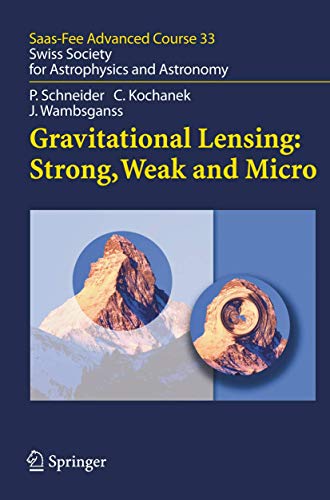Gravitational Lensing: Strong, Weak and Micro: Swiss Society for Astrophysics and Astronomy: 33 (Saas-Fee Advanced Course) - Hardcover

Zu dieser ISBN ist aktuell kein Angebot verfügbar.
Alle Exemplare der Ausgabe mit dieser ISBN anzeigen:Die Inhaltsangabe kann sich auf eine andere Ausgabe dieses Titels beziehen.
The theory, observations, and applications of gravitational lensing constitute one of the most rapidly growing branches of astrophysics. The gravitational deflection of light generated by mass concentrations along a light path produces magnification, multiplicity, and distortion of images and delays photon propagation from one line of sight relative to another. The huge amount of scientific work on gravitational lensing produced over the last decade has clearly revealed its already substantial and wide impact and its potential for future astrophysical applications.
The up-to-date contributions in this book are based on the lecture notes of the 33rd Saas–Fee Advanced Course of the Swiss Society of Astronomy and Astrophysics, entitled Gravitational Lensing: Strong, Weak, and Micro. The book comprises four complementary parts, written by leading experts in the field, constituting a genuine textbook about gravitational lensing:
· Peter Schneider – Part 1: Introduction to Gravitational Lensing and Cosmology
· Christopher Kochanek – Part 2: Strong Gravitational Lensing
· Peter Schneider – Part 3: Weak Gravitational Lensing
· Joachim Wambsganss – Part 4: Gravitational Microlensing
Students and researchers alike will benefit from this comprehensive presentation of the astrophysical and astronomical aspects of gravitational lensing.
„Über diesen Titel“ kann sich auf eine andere Ausgabe dieses Titels beziehen.
- VerlagSpringer
- Erscheinungsdatum2006
- ISBN 10 354030309X
- ISBN 13 9783540303091
- EinbandTapa dura
- Anzahl der Seiten572
- HerausgeberMeylan Georges, Jetzer Philippe, North Pierre
Neu kaufen
Mehr zu diesem Angebot erfahren
Versand:
EUR 48,99
Von Deutschland nach USA
Beste Suchergebnisse beim ZVAB
Gravitational Lensing: Strong, Weak and Micro
Buchbeschreibung Gebunden. Zustand: New. Artikel-Nr. 4887389
Weitere Informationen zu diesem Verkäufer | Verkäufer kontaktieren
Gravitational Lensing: Strong, Weak and Micro : Saas-Fee Advanced Course 33
Buchbeschreibung Buch. Zustand: Neu. Druck auf Anfrage Neuware - Printed after ordering - The observation, in 1919 by A.S. Eddington and collaborators, of the gra- tational de ection of light by the Sun proved one of the many predictions of Einstein's Theory of General Relativity: The Sun was the rst example of a gravitational lens. In 1936, Albert Einstein published an article in which he suggested - ing stars as gravitational lenses. A year later, Fritz Zwicky pointed out that galaxies would act as lenses much more likely than stars, and also gave a list of possible applications, as a means to determine the dark matter content of galaxies and clusters of galaxies. It was only in 1979 that the rst example of an extragalactic gravitational lens was provided by the observation of the distant quasar QSO 0957+0561, by D. Walsh, R.F. Carswell, and R.J. Weymann. A few years later, the rst lens showing images in the form of arcs was detected. The theory, observations, and applications of gravitational lensing cons- tute one of the most rapidly growing branches of astrophysics. The gravi- tional de ection of light generated by mass concentrations along a light path producesmagni cation,multiplicity,anddistortionofimages,anddelaysp- ton propagation from one line of sight relative to another. The huge amount of scienti c work produced over the last decade on gravitational lensing has clearly revealed its already substantial and wide impact, and its potential for future astrophysical applications. Artikel-Nr. 9783540303091
Weitere Informationen zu diesem Verkäufer | Verkäufer kontaktieren

